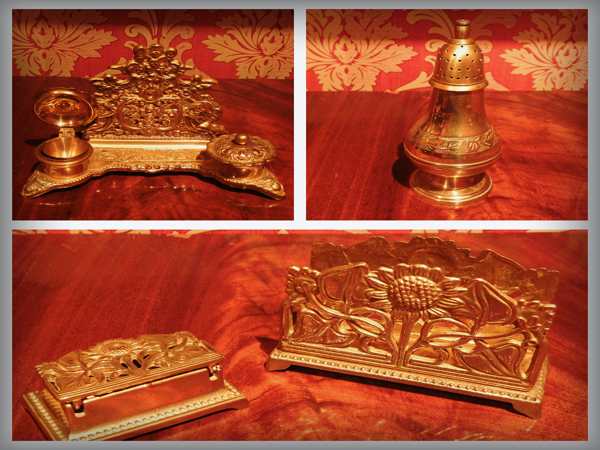Today, we’re not diving into the depths of DIY projects but exploring the art of finding and repurposing vintage treasures. Our focus? The charming accessories adorning the top of your bureau. Let’s delve into the stories behind these unique pieces, each with its own history and personality.
A Desk Set with a Story
Your brass desk set, complete with a letter rack, inkwells, and a pen-rest, is a lovely addition. While its exact origin remains shrouded in time, its modern feel with a vintage touch suggests it might be a replica. Genuine antique desk sets often feature glass inkwells, whereas yours have turned brass inserts. Regardless of its age, its aesthetic appeal and practical function make it a delightful centerpiece.
A Touch of Brass and Dandelion Delight
The brass letter rack and stamp box you acquired from the Times Past shop in Southport are another charming pair. Their vintage-inspired dandelion patterns add a touch of whimsy to your workspace. These pieces demonstrate the beauty of well-crafted replicas that capture the essence of antique style without the hefty price tag.
A Sand Sifter for the Ink-Dipped Pen:
Your brass sifter, a recent find at a charity shop, is a fascinating historical artifact. In the days of pen and ink, writers used sand to absorb excess ink and prevent smudges. The sifter held fine silver sand, which was sprinkled onto the freshly written text. While it might seem messy today, it was a necessary step in the writing process.
Trench Art: A Tangible Link to the Past
The pen/pencil holder is a poignant piece of trench art, a testament to the ingenuity of soldiers during World War I. These handcrafted items, often made from repurposed brass shell casings, were a source of comfort and creativity for soldiers stationed in the trenches. Your grandfather’s possession of this piece underscores the enduring impact of the war on families and communities.
A Letter Knife with a Story:
The ivory letter knife attached to your pen is another intriguing item. Ivory was once widely used for various objects, from piano keys to decorative ornaments. Unfortunately, the demand for ivory has led to illegal poaching and the exploitation of elephants. Thankfully, there are ways to distinguish genuine ivory from its synthetic counterparts.
Identifying Ivory: A Guide for Collectors
To identify ivory, look for dark lines and markings, which are characteristic of bone. Ivory, being tooth, tends to be more uniform in appearance. Modern techniques have also given rise to “Hong Kong ivory,” a resin mixture with ground ox bone dust, and straight resin casts designed to mimic ivory.
A simple test can help you determine the authenticity of an ivory item. Using a heated needle, gently apply it to an inconspicuous area. Ivory will resist the needle and emit a burnt bone odor. Resin, on the other hand, will easily puncture and produce a plastic-like smell with visible bubbles.
Preserving History and Promoting Ethical Practices
By understanding the history and characteristics of these vintage items, we can appreciate their value and contribute to efforts to combat illegal ivory trade. Supporting ethical collectors and sellers is crucial in preserving our heritage and ensuring the protection of endangered species.
As you continue to decorate your study with found treasures, remember the stories behind each piece. These objects are more than just decorations; they are tangible links to the past, reminders of the ingenuity, creativity, and resilience of those who came before us.

